The Gift of South Dakota
Subscriptions to South Dakota Magazine make great gifts!
Subscribe today — 1 year (6 issues) is just $29!
Grottos of South Dakota
Nov 6, 2019
The Midwest was host to a unique folk art movement in the early 20th century, as German-American Catholics brought with them the grotto tradition. There are two small grottos in South Dakota, on opposite ends of the state: Saint Peter's in Farmer, and Saint Martin's in Oelrichs.
The Midwestern grotto tradition was kickstarted by Father Paul Dobberstein with the Grotto of the Redemption in West Bend, Iowa. Near-death experiences are a common theme in grotto-building origin stories. Father Dobberstein promised the Virgin Mary that if he survived a bout with pneumonia, he would build one. And he did. In 1894, he built a small grotto, Our Lady of Lourdes, at the Saint Francis de Sales Seminary outside Milwaukee.
He wasn't done though. He began to amass a collection of boulders for his magnum opus, which he began in 1912 and continued until his death in 1954. A parishioner named Matt Szerence helped him from the start, continuing also until his death in 1959.
The two artists often made excavation runs to the Black Hills, returning with rocks removed by miners or railroads. They studded the surfaces with colorful minerals, gemstones, petrified wood and glass. The Grotto of the Redemption is actually a series of nine grottos that tell the Catholic story of Redemption, beginning with the Fall of Man and culminating with the Resurrection.
Perhaps the second most famous Midwestern grotto is the Dickeyville Grotto and Shrines, built by Father Matthias Wernerus in the eponymous small Wisconsin town between 1925 and 1930. Probably inspired in part by Dobberstein's work, Dickeyville is a tribute to God and country, combining patriotic and religious themes. With his splashy use of color — utilizing semi-precious stones, glass and pottery shards — Wernerus prefigured later religious folk artists, working in different mediums, like Howard Finster at Paradise Gardens or Leonard Knight at Salvation Mountain.
The South Dakota grottos are neither as grand in scale as the Grotto of the Redemption, or as visually frenetic as Dickeyville.
Saint Martin's in Oelrichs is the most austere, relying less on colorfully ornamented concrete, and more on the stone bounty of the Southern Black Hills to recreate a naturalistic cavern for the Virgin Mary. Father Gerhard Stakemeir, another German American priest, built the icon between 1932 and 1934, with help from parishioner Nick Bogner. According to the National Register of Historic Places, Stakemeir and Bogner utilized, "petrified wood and moss, and fossils taken from Wind Cave National Park.
"The car tunnels leading through Wind Cave National Park were being enlarged in the late 1920s and early 1930s, which left vast amounts of debris … Bogner used a trailer and his Buick to haul the rocks from the passes to aid Father Stakemeir's project."
The bells no longer ring at Saint Martin's, which closed as a church in 1999, a victim of rural decline. The property owner maintains the grotto, which receives few visitors.
Father Peter Scheier built the Byzantine-style Saint Peter's grotto in Farmer between 1926 and 1933. Scheier may have been more influenced by his contemporaries in West Bend and Dickeyville than Father Stakemeir was at Oelrichs. The facade of the turrets and walls at Farmer are decoratively studded with thousands of fresh-water seashells and shards of colored glass, among the gathered stones. Like Stakemeir, and even Paul Dobberstein, Scheier made excursions to the Black Hills to gather materials. The Farmer grotto is cherished by alums and locals, some of whom took part in a restoration project in the early 2000s.
Maybe it's just a coincidence, but Lemmon's Petrified Wood Park — one of South Dakota's great folk art monuments, which could be seen as a secular take on the grotto movement, in which fossils and stone foster the contemplation of deep time (or at least put Lemmon on the map) rather than the glorification of God — was built during the peak of the Midwestern grotto-building era (1930-1932).
In its grandiosity of scale, Ole Quammen's Petrified Wood Park shares more in common with the Grotto of the Redemption or Dickeyville than Stakemeir's or Scheier's smaller icons, nearly swallowed by the prairie and demography.
Saint Martin's and Saint Peter's remain modest reminders of an interesting moment in sacral folk art.
Michael Zimny is the social media engagement specialist for South Dakota Public Broadcasting in Vermillion. He blogs for SDPB and contributes arts columns to the South Dakota Magazine website.


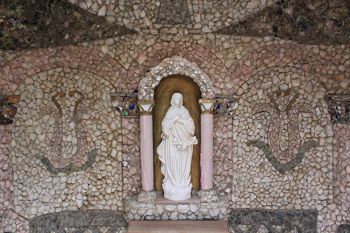
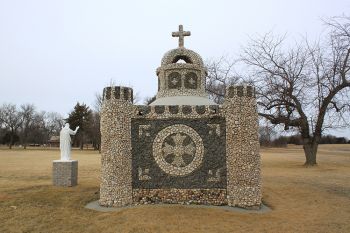

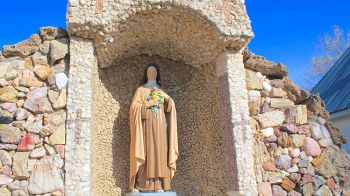
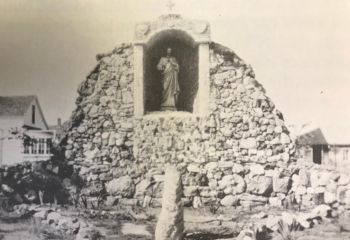

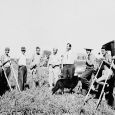
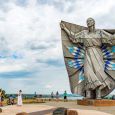





Comments
The hospital has long since been torn down and the statue of Mary is gone but the grotto remains